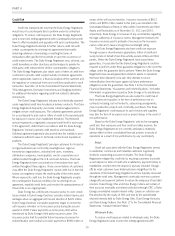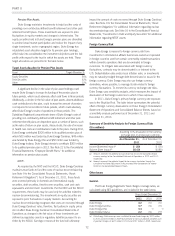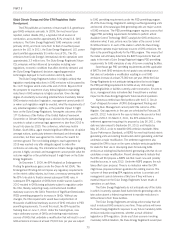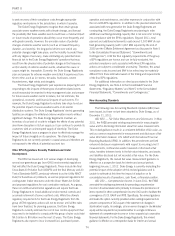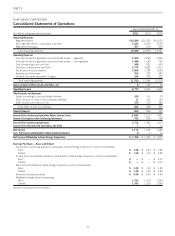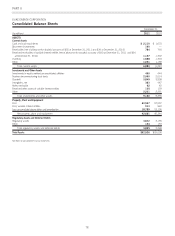Duke Energy 2011 Annual Report Download - page 94
Download and view the complete annual report
Please find page 94 of the 2011 Duke Energy annual report below. You can navigate through the pages in the report by either clicking on the pages listed below, or by using the keyword search tool below to find specific information within the annual report.
PART II
to seek recovery of their compliance costs through appropriate
regulatory mechanisms in the jurisdictions in which it operates.
The Duke Energy Registrants recognize that certain groups
associate severe weather events with climate change, and forecast
the possibility that these weather events could have a material impact
on future results of operations should they occur more frequently and
with greater severity. However, the uncertain nature of potential
changes of extreme weather events (such as increased frequency,
duration, and severity), the long period of time over which any
potential changes might take place, and the inability to predict these
with any degree of accuracy, make estimating any potential future
financial risk to the Duke Energy Registrants’ operations that may
result from the physical risks of potential changes in the frequency
and/or severity of extreme weather events, whatever the cause or
causes might be, impossible. Currently, the Duke Energy Registrants
plan and prepare for extreme weather events that it experiences from
time to time, such as ice storms, tornados, hurricanes, severe
thunderstorms, high winds and droughts.
The Duke Energy Registrants’ past experiences preparing for and
responding to the impacts of these types of weather-related events
would reasonably be expected to help management plan and prepare
for future severe weather events to reduce, but not eliminate, the
operational, economic and financial impacts of such events. For
example, the Duke Energy Registrants routinely take steps to reduce
the potential impact of severe weather events on its electric
distribution systems. The Duke Energy Registrants’ electric generating
facilities are designed to withstand extreme weather events without
significant damage. The Duke Energy Registrants maintain an
inventory of coal and oil on site to mitigate the effects of any potential
short-term disruption in its fuel supply so it can continue to provide its
customers with an uninterrupted supply of electricity. The Duke
Energy Registrants have a program in place to effectively manage the
impact of future droughts on its operations. The Duke Energy
Registrants do not currently operate in coastal areas and therefore are
not exposed to the effects of potential sea level rise.
Other EPA Regulations Recently Published and Under
Development.
The EPA has issued and is in various stages of developing
several non-greenhouse gas (non-GHG) environmental regulations
that will affect the Duke Energy Registrants. These include the final
Cross-State Air Pollution Rule (CSAPR) and the final Mercury and Air
Toxics Standards (MATS, previously referred to as the Utility MACT
Rule) for hazardous air pollutants, as well as proposed regulations for
cooling water intake structures under the Clean Water Act 316(b)
and proposed regulations for coal combustion residuals. As a group,
these non-GHG environmental regulations will require the Duke
Energy Registrants to install additional environmental controls and
accelerate retirement of some coal-fired units. While the ultimate
regulatory requirements for the Duke Energy Registrants from the
group of EPA regulatory actions will not be known until all the rules
have been finalized, for planning purposes, the Duke Energy
Registrants currently estimate the cost of new control equipment that
may need to be installed to comply with this group of rules could total
$4.5 billion to $5 billion over the next 10 years. The Duke Energy
Registrants also expect to incur increased fuel, purchased power,
operation and maintenance, and other expenses in conjunction with
the non-GHG EPA regulations. In addition to the planned retirements
associated with new generation the Duke Energy Registrants are
constructing, the Duke Energy Registrants are planning to retire
additional coal fired generating capacity that is not economic to bring
into compliance with the EPA’s regulations. Beyond 2011, total
planned and additional retirements could exceed 3,300 MW of coal-
fired generating capacity (with 1,667 MW required by the end of
2020 per the Cliffside Settlement Agreement as discussed in Note 5
to the Consolidated Financial Statement, “Commitments and
Contingencies”). Until the final regulatory requirements of the group
of EPA regulations are known and can be fully evaluated, the
potential compliance costs associated with these EPA regulatory
actions are subject to considerable uncertainty. Therefore, the actual
compliance costs incurred and MW to be retired may be materially
different from these estimates based on the timing and requirements
of the final EPA regulations.
For additional information on other issues related to the Duke
Energy Registrants, see Note 4 to the Consolidated Financial
Statements, “Regulatory Matters” and Note 5 to the Consolidated
Financial Statements, “Commitments and Contingencies.”
New Accounting Standards
The following new Accounting Standards Updates (ASU) have
been issued, but have not yet been adopted by Duke Energy, as of
December 31, 2011:
ASC 820 — Fair Value Measurements and Disclosures. In May
2011, the FASB amended existing requirements for measuring fair
value and for disclosing information about fair value measurements.
This revised guidance results in a consistent definition of fair value, as
well as common requirements for measurement and disclosure of fair
value information between U.S. GAAP and International Financial
Reporting Standards (IFRS). In addition, the amendments set forth
enhanced disclosure requirements with respect to recurring Level 3
measurements, nonfinancial assets measured or disclosed at fair
value, transfers between levels in the fair value hierarchy, and assets
and liabilities disclosed but not recorded at fair value. For the Duke
Energy Registrants, the revised fair value measurement guidance is
effective on a prospective basis for interim and annual periods
beginning January 1, 2012. Duke Energy is currently evaluating the
potential impact of the adoption of this revised guidance and is
unable to estimate at this time the impact of adoption on its
consolidated results of operations, cash flows, or financial position.
ASC 220 — Comprehensive Income. In June 2011, the FASB
amended the existing requirements for presenting comprehensive
income in financial statements primarily to increase the prominence of
items reported in other comprehensive income (OCI) and to facilitate the
convergence of U.S. GAAP and IFRS. Specifically, the revised guidance
eliminates the option currently provided under existing requirements to
present components of OCI as part of the statement of changes in
stockholders’ equity. Accordingly, all non-owner changes in stockholders’
equity will be required to be presented either in a single continuous
statement of comprehensive income or in two separate but consecutive
financial statements. For the Duke Energy Registrants, this revised
guidance is effective on a retrospective basis for interim and annual
74








